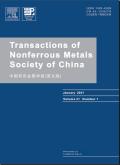Formation mechanism of nanopores in dense films of anodic alumina
IF 4.7
1区 材料科学
Q1 METALLURGY & METALLURGICAL ENGINEERING
Transactions of Nonferrous Metals Society of China
Pub Date : 2024-09-01
DOI:10.1016/S1003-6326(24)66585-4
引用次数: 0
Abstract
Constant-current anodization of pure aluminum was carried out in non-corrosive capacitor working electrolytes to study the formation mechanism of nanopores in the anodic oxide films. Through comparative experiments, nanopores are found in the anodic films formed in the electrolytes after high-temperature storage (HTS) at 130 °C for 240 h. A comparison of the voltage−time curves suggests that the formation of nanopores results from the decrease in formation efficiency of anodic oxide films rather than the corrosion of the electrolytes. FT-IR and UV spectra analysis shows that carboxylate and ethylene glycol in electrolytes can easily react by esterification at high temperatures. Combining the electronic current theory and oxygen bubble mold effect, the change in electrolyte composition could increase the electronic current in the anodizing process. The electronic current decreases the formation efficiency of anodic oxide films, and oxygen bubbles accompanying electronic current lead to the formation of nanopores in the dense films. The continuous electronic current and oxygen bubbles are the prerequisites for the formation of porous anodic oxides rather than the traditional field-assisted dissolution model.
阳极氧化铝致密薄膜中纳米孔的形成机理
在非腐蚀性电容器工作电解液中对纯铝进行了恒流阳极氧化,以研究阳极氧化膜中纳米孔的形成机理。电压-时间曲线的比较表明,纳米孔的形成是阳极氧化膜形成效率下降的结果,而不是电解液腐蚀的结果。傅立叶变换红外光谱和紫外光谱分析表明,电解质中的羧酸盐和乙二醇在高温下很容易发生酯化反应。结合电子电流理论和氧泡模塑效应,电解液成分的改变会增加阳极氧化过程中的电子电流。电子电流会降低阳极氧化膜的形成效率,而伴随电子电流产生的氧泡则会在致密膜中形成纳米孔。持续的电子电流和氧气泡是形成多孔阳极氧化物的先决条件,而不是传统的场辅助溶解模式。
本文章由计算机程序翻译,如有差异,请以英文原文为准。
求助全文
约1分钟内获得全文
求助全文
来源期刊
CiteScore
7.40
自引率
17.80%
发文量
8456
审稿时长
3.6 months
期刊介绍:
The Transactions of Nonferrous Metals Society of China (Trans. Nonferrous Met. Soc. China), founded in 1991 and sponsored by The Nonferrous Metals Society of China, is published monthly now and mainly contains reports of original research which reflect the new progresses in the field of nonferrous metals science and technology, including mineral processing, extraction metallurgy, metallic materials and heat treatments, metal working, physical metallurgy, powder metallurgy, with the emphasis on fundamental science. It is the unique preeminent publication in English for scientists, engineers, under/post-graduates on the field of nonferrous metals industry. This journal is covered by many famous abstract/index systems and databases such as SCI Expanded, Ei Compendex Plus, INSPEC, CA, METADEX, AJ and JICST.

 求助内容:
求助内容: 应助结果提醒方式:
应助结果提醒方式:


